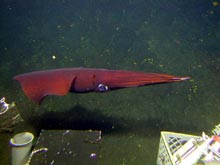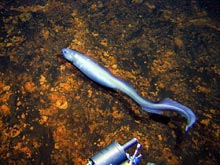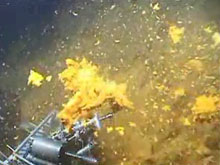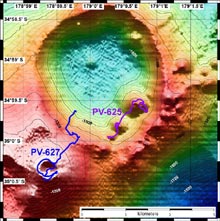
Healy submarine volcano with Pisces V dive tracks (PV-625 and PV-627) overlaid on the bathymetry. Depths in the area of the dives range from 1120 to 1490 meters (3675 - 4890 feet). The resolution of the bathymetry data is 25 meters. The contour interval is 20 meters. Click image for larger view
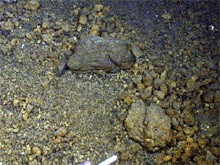
View a slide show of the seafloor surrounding Healy caldera, where metal-rich hydrothermal plumes were discovered.
![]() Click
image to view a slide show.
Click
image to view a slide show.
First Explorations of Healy Volcano Where did all this iron come from?
May 4, 2005
Bob Embley
Co-Chief Scientist for the New Zealand American Submarine Ring of Fire Expedition
(Legs 1 and 2)
Geophysicist
NOAA Vents Program, Pacific Marine Environmental Laboratory – Newport,
Oregon
Gary Massoth
Co-Chief Scientist for the New Zealand American Submarine Ring of Fire Expedition
(Leg 1)
Principle Scientist
Institute of Geological and Nuclear Sciences Ltd
Lower Hutt, New Zealand
Ian Wright
Ocean Geology
National Institute of Water and Atmospheric Research
Wellington, New Zealand
![]() Fish, crabs, skates, and squid were among the animals encountered at Healy volcano. (Quicktime, 2.3 Mb.)
Fish, crabs, skates, and squid were among the animals encountered at Healy volcano. (Quicktime, 2.3 Mb.)
![]() Thick,
iron-stained, yellow bacterial mat forms strangely shaped chimneys and
other structures where warm water is seeping out of Healy volcano. (Quicktime,
2.1 Mb.)
Thick,
iron-stained, yellow bacterial mat forms strangely shaped chimneys and
other structures where warm water is seeping out of Healy volcano. (Quicktime,
2.1 Mb.)
![]() Pervasive
diffuse venting at Healy volcano mantles the upper slopes in thick fluffy
bacterial mat, like fresh powdery snow on a ski slope. (Quicktime, 2.1
Mb.)
Pervasive
diffuse venting at Healy volcano mantles the upper slopes in thick fluffy
bacterial mat, like fresh powdery snow on a ski slope. (Quicktime, 2.1
Mb.)
![]() Whitish ash layers and large deposits of pumice are evidence of Healy volcano's explosive past. (Quicktime, 2.1 Mb.)
Whitish ash layers and large deposits of pumice are evidence of Healy volcano's explosive past. (Quicktime, 2.1 Mb.)
Healy Volcano's main caldera and surrounding seafloor are littered with
pumice fragments from its last major eruption, estimated to be less than
5000 years ago. This event probably formed Healy's main 2 mile-wide caldera
in a paroxysmal eruption. Pumice is a very porous, low density rock that
is ejected during submarine eruptions when the magma is rich in silica and
gas. Post-dating the eruption are several small volcanic cones lined up
along a NE-SW trending fracture near the eastern wall of the caldera (![]() View evidence of Healy volcano's explosive past).
View evidence of Healy volcano's explosive past).
There were high expectations of new life forms and new fields of black
smoker chimneys leading up to the first dive at Healy Volcano. The water-column
plumes during the NZAPLUME cruises discovered metal-rich hydrothermal plumes
contained within the caldera. Pisces soon encountered what was to be a primary “style” of
hydrothermal venting in Healy caldera. The three cones within Healy's main
caldera visited during Dive 625, and part of the large cone lying outside
the caldera to the southwest (explored on Dive 627), were covered with blankets
of orange-red microbial mats and delicate and intricate chimneys of material
rich in iron and silica (![]() View strangely shaped chimneys and other structures). The temperature was relatively low at 34° C
(93° F), and there were no large fauna associated with these vents.
Larger fish and squid were occasionally seen gliding over the orange-stained
seafloor. This is because the iron-rich fluids are almost completely devoid
of hydrogen sulfide, which fuels the biologic communities at so many of
the other Kermadec volcanoes we have visited.
View strangely shaped chimneys and other structures). The temperature was relatively low at 34° C
(93° F), and there were no large fauna associated with these vents.
Larger fish and squid were occasionally seen gliding over the orange-stained
seafloor. This is because the iron-rich fluids are almost completely devoid
of hydrogen sulfide, which fuels the biologic communities at so many of
the other Kermadec volcanoes we have visited.
The other surprise is that the volcanic cones are composed of basalt, instead of the rhyolite that makes up much of the older caldera. The type of magma being generated beneath the volcano has switched from a high-silica - "sticky" - magma to lower silica, less viscous basaltic lava. Why is this and how does it relate to the iron-rich venting discovered here? We don't know the answer to this question, although there are some spirited discussions among the science team on board. In any case, surprises like this are what moves science ahead to a new understanding of how these volcanoes work.
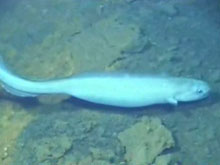
![]() Fish,
crabs, skates, and squid were among the animals encountered at
Healy volcano. (Quicktime, 2.3
Mb.)
Fish,
crabs, skates, and squid were among the animals encountered at
Healy volcano. (Quicktime, 2.3
Mb.)
Sign up for the Ocean Explorer E-mail Update List.



























